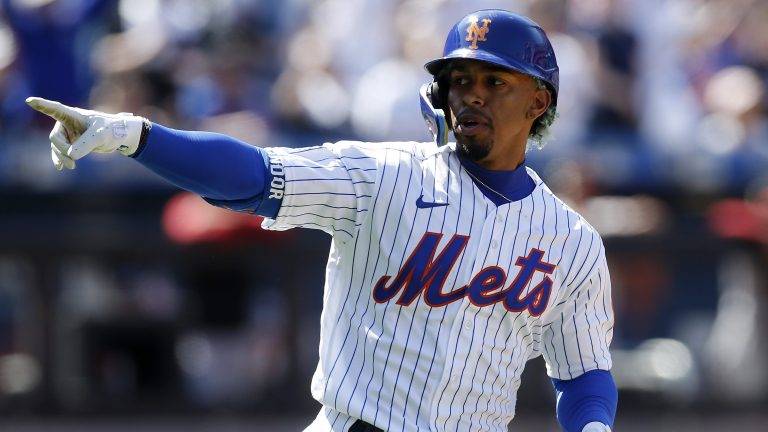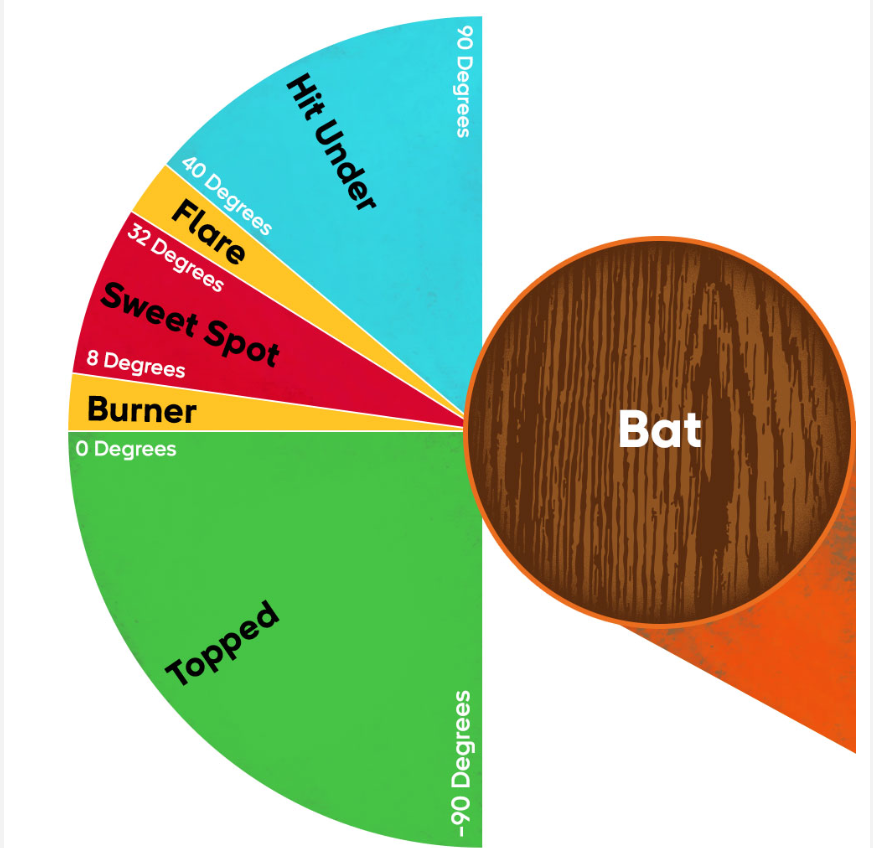Why Francisco Lindor Will Be Better for the Mets Soon
Francisco Lindor got off to a brutal start to the 2024 season, but the stats suggest a turnaround is imminent for the Mets star shortstop.

One of the early stories this season for the New York Mets has been the play of superstar shortstop Francisco Lindor. The 30-year-old started the season going hitless in seven of his first eight games, and has spent most of the season with a batting average well below the Mendoza line.
It took going 4-for-5 against the Giants on Wednesday for Lindor to finally get his average above .200 for the season. Lindor hit two home runs in the game, driving in four runs as he doubled his home run total and nearly doubled his RBI total in a single contest.
This capped off what was a fantastic road trip for Lindor, where he also played hero in the Mets series victory over the Dodgers last weekend. Lindor drove in two runs in each of the Mets wins over the Dodgers, including a clutch seventh inning homer in Game 1 that gave his team a late lead.
Prior to his home run against the Dodgers, Lindor had just two RBIs through the Mets first 19 games. Since then, Lindor has driven in eight runs over the past five games, hitting three home runs during that span.
For the Mets shortstop, this represents the first time we have seen him making consistent loud contact all season. Is there a reason behind the sudden power surge for Lindor?
If you take the time to dive into the numbers so far on Lindor, what you will find is a player who has not gotten results one would expect, but not a player that has been overmatched or one that is far away from making a huge impact with his bat again.
Francisco Lindor is Making Lots of Contact
Lindor started this season going 1-for-31, as he went into the final game of the Mets series against the Reds on April 7th with a dismal .032 batting average. Getting to bat from his dominant right side, Lindor went 2-for-5 with a home run and a double, representing his first good game of the season.
Since then, Lindor has gone 19-for-66, as he has hit .287/.347/.515 across his last 16 games played.
He followed up his one great game in Cincinnati with a rough 2-for-15 series against the Braves in Atlanta. On April 14th, Lindor got to face a left-handed pitcher once again and got two hits off of Cole Ragans. The following night, Lindor got two hits off another lefty in Martin Perez.
Still, it was not until Lindor got late hits against Dodgers right-handed relievers Daniel Hudson and Ryan Brasier that it felt like he had found any success with his left-handed swing. Now after three good left-handed games on the West Coast trip, Lindor is starting to look like himself again.
What the numbers tell us though is that Lindor was never that far away from being the guy he has been throughout his career, despite the lack of results.
Going into Wednesday’s game, Lindor had an expected batting average of .254 on the season. That numbers matches what Lindor put up in 2021 and 2022, while being just a point shy of what he posted in 2023. After his four-hit game on Wednesday, Lindor has an xBA of .265.
Why is Lindor’s expected batting average so high in comparison to his actual average?
The reason is a lack of quality contact from Lindor, but the contact itself has not been the issue. Lindor has a ZoneContact% of 89.1 percent, which is just a shade below his career 89.6% mark.
Lindor’s strikeout rate is actually down this year, from a career-high 19.9% in 2023, to the lowest K-rate he has had in a Mets uniform at 14.5%. Lindor’s batting average on balls in play is sitting at .205 this year, which is 85 points below his career mark.
Looking at what Lindor has done against fastballs, he has hit just .231, despite the fact that his expected batting average on fastballs is at .329 and his expected slug is at .522. That expected slug is almost 200 points better than his actual slugging percentage of .333.
Those numbers suggest imminent positive regression for Lindor, coming off two seasons were he has been a quality run-producer for the Mets.
Lindor Just Needs to Find More Barrels
Looking at where things have gone wrong for Lindor, the biggest issue has been the quality of contact when it comes to finding the barrel. Prior to blasting two home runs in his last game, Lindor’s Barrel% on the season was sitting at just 3.9%.
By hitting those two home runs with exit velocities well above 100 MPH, Lindor added a few more barrels to his season total, and brought up his Barrel% to 6.1%. Now this is still down from the career-best 10.4% Barrel% he posted last year, but shows a marked improvement.
Now before we get too far down the rabbit hole of Barrel% and Sweet-Spot%, what exactly do these numbers mean?
According to MLB.com: The Barrel classification is assigned to batted-ball events whose comparable hit types (in terms of exit velocity and launch angle) have led to a minimum .500 batting average and 1.500 slugging percentage since Statcast was implemented Major League wide in 2015.”
To be Barreled, a batted ball requires an exit velocity of at least 98 mph. At that speed, balls struck with a launch angle between 26-30 degrees always garner Barreled classification. For every mph over 98, the range of launch angles expands.
Looking at Lindor’s home runs on Wednesday, the first one he hit had an exit velocity of 102.6 MPH, with a launch angle of 34 degrees. Even though he got slightly under it, this qualified as a barrel because he hit it so hard.
His second home run was even better, as Lindor scorched the ball with an exit velocity of 105.8 MPH, which is now his max exit velocity of the season. His launch angle on the home run was at 29 degrees, which means he found the Sweet-Spot of the barrel that falls between 8 and 32 degrees.
One of the biggest areas of drop-off for Lindor so far this season has been his Sweet-Spot%, going from around 36% last year, to just 25.6% this year. To understand Sweet-Spot%, look at this visual representation that can be found at MLB.com.

As you can see above, launch angle can be divided into five different sections to help explain the type of contact that a batted ball event will produce. Anything from 0 to -90 degrees is categorized as being “topped”, which is getting on top of the baseball and hammering it into the ground.
Anything from 40 degrees to 90 degrees is considered “hit under”, which is generally going to produce flyouts and popouts that hang in the air too long to fall for hits.
Then you have flares and burners, which represent the eight degrees of separation either way between finding the sweet-spot of the barrel and getting under or topping the baseball instead. You can almost categorize this in your mind as batted ball events where the batter just misses he intended target on the barrel.
All of this is relevant to Lindor because when we look at the different categorizations of his profile, it is the flares/burners where he has seen the biggest discrepancy from last year.
| Year | Topped% | Under% | Flare/Burner% |
| 2023 | 23.9% | 33.1% | 23.3% |
| 2024 | 23.2% | 31.7% | 26.8% |
Prior to yesterday’s game, Lindor’s Flare/Burner% was even higher at 27.3%. Even now with that rate dropping half a percent, this would be the highest Flare/Burner% for Lindor since 2016.
If we had seen a great spike in his topped% or under%, it would be more concerning that Lindor was missing by a lot, but a spike in his Flare/Burner% indicates that he has not been too far off from making solid contact.
Over the past 10 games, Lindor has picked up multiple-hit games on five different occasions, as he is really starting to find his stroke. If Lindor can get back to finding the Sweet-Spot of his bat on a more consistent basis, the barrels are sure to follow, as will the extra-base hits.
One Area Concern for Lindor Moving Forward
After looking over everything with Lindor, it is pretty clear that the slump that plagued him to start the year will not carry over throughout the season. If Lindor was getting blown up on a consistent basis, striking out while failing to make contact, we could be concerned.
If Lindor was getting on top of everything, or under everything and was nowhere close to finding the Sweet-Spot of the barrel, that could be cause for concern. Instead, Lindor’s numbers suggest a bit of bad luck, which should correct itself in the coming days and weeks.
However if there was anything that is a cause for concern, it is how Lindor has fared so far against offspeed pitches. Lindor is hitting just .150 with a .200 slugging percentage against offspeed pitches. His Putaway% against those pitches is sitting at 40%, as he has swung through his fair share of change-ups and splitters in the early going this year.
Last year, Lindor crushed change-ups to the tune of a .338 average and a .592 slugging percentage with a positive run value of +12. In 2022, Lindor’s run value against the change-up was +8, with an average of .313 against the pitch.
Splitters have consistently given Lindor trouble throughout his career, and they are now more prevalent in the game then ever before. So that is one pitch that Lindor may continue to struggle with, but the change-up should eventually be a pitch that he can come around on.
Overall, Francisco Lindor is just too good of a player to turn in a season as bad as what we have seen up to this point in the year. The numbers suggest that he can turn things around soon, and if this past West Coast trip was any indication, he is already well on his way to doing just that.
